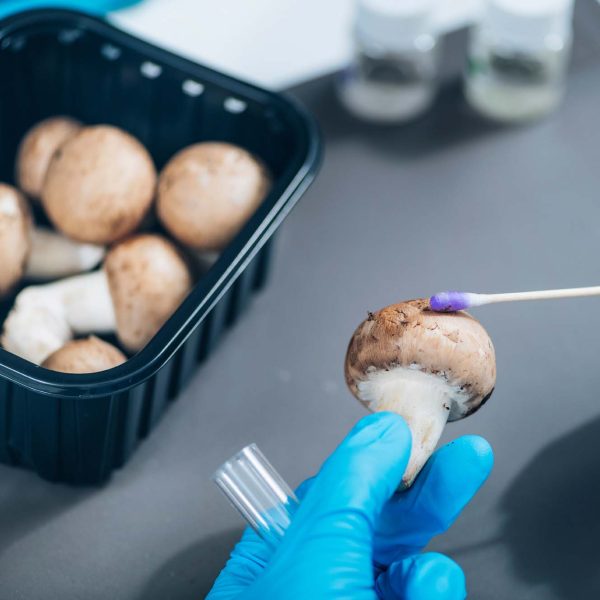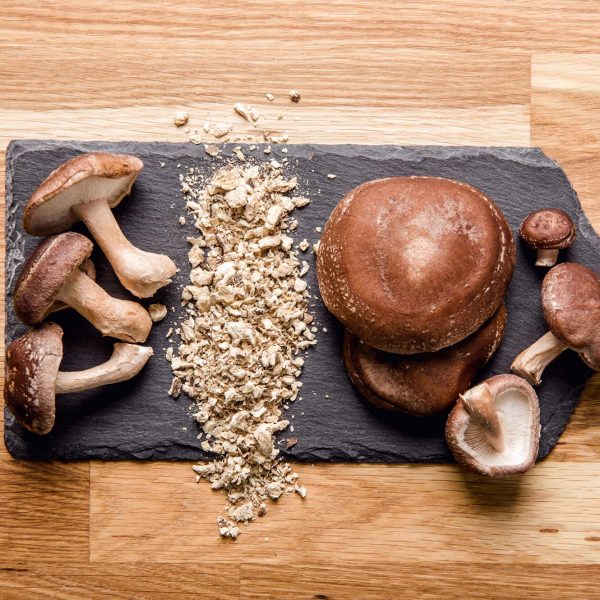
Nutrition
Research
See below for a list of existing research on the nutrients in mushrooms and how they may help in disease prevention. This research is just the beginning of what is sure to be an exciting journey into a fuller understanding of mushrooms and your health.
Mushrooms & Your Health

Cancer
Over the last decade, City of Hope researchers identified and tested cancer-inhibiting compounds in the common supermarket mushroom. Their work has moved into clinical trials at City of Hope, including the areas of suppressed growth of breast cancer and prostate cancer cells. Click here to read the latest on City of Hope’s work with mushrooms.

Just Add Mushrooms
Researchers have identified another good reason to eat more mushrooms. Research, published in Food Science & Nutrition (January 2021), found that adding a mushroom serving to the diet increased the intake of several micronutrients, including shortfall nutrients such as vitamin D, without any increase in calories, sodium or fat.8 Read more here.

Weight Management
Mushrooms are hearty and filling. Preliminary research suggests increasing intake of low energy dense foods, meaning few calories given the volume of food, specifically mushrooms, in place of high energy dense foods like lean ground beef can be helpful with weight management as they promote daily energy by limiting fat intake and leaving you full and satiated after a meal.5 Click here to read the full study.

Sodium Reduction
The 2020-2025 Dietary Guidelines for Americans encourages healthy dietary patterns that are low in sodium. Mushrooms are fat free, low in sodium and their inherent umami counterbalances saltiness and allows for less salt to be used in recipes. Learn more about the Culinary Institute of America’s work with mushrooms and sodium reduction.
This research section is organized by topics of interest. For nutrition composition of common edible and culinary mushrooms, see: U.S. Department of Agriculture, Agricultural Research Service. FoodData Central, 2019. fdc.nal.usda.gov.
- Ba, DM, Sentongo P, Beelman RD, Muscat J, Gao X and Richie Jr JP. Higher Mushroom Consumption is Associated with Lower Risk of Cancer: A Systematic Review and Meta-Analysis of Observational Studies. Adv Nutr 2021; 12(5):1691-1704. Doi:10.1093/advances/nmab015.
- Zhang S, Sugawara Y, Chen S, Beelman RB, Tsuduki T, Tomata Y, Matsuyama S, Tsuji Mushroom consumption and incident risk of prostate cancer in Japan: A pooled analysis of the Miyagi Cohort Study and the Ohsaki Cohort Study. Int J Cancer. 2020 May 15;146(10):2712-2720. doi: 10.1002/ijc.32591. Epub 2019 Sep 4. PMID: 31486077; PMCID: PMC7154543.
- Lee DH, Yang M, Keum N, Giovannucci EL, Sun Q, Chavarro JE. Mushroom Consumption and Risk of Total and Site-Specific Cancer in Two Large U.S. Prospective Cohorts. Cancer Prev Res (Phila). 2019 Aug;12(8):517-526. doi: 10.1158/1940-6207.CAPR-19-0101. Epub 2019 Jun 4. PMID: 31164344; PMCID: PMC6677603.
- Twardowski P, Kanaya N, Frankel P, Synold T, Ruel C, et al. A phase I trial of mushroom powder in patients with biochemically recurrent prostate cancer: Roles of cytokines and myeloid-derived suppressor cells for Agaricus bisporus-induced prostate-specific antigen responses. Cancer 2015; May 18. doi. 10.10.1002/cncr.29421.
- Li J, Zou L, Chen W, et al. Dietary mushroom intake may reduce the risk of beast cancer: Evidence from a meta-analysis of observational studies. PLOS One. 2014, DOI: 10.1371/journal.pone.0093437.
- Suzuki N, Yuko T, Riho S, et al. Efficacy of oral administration of Lentinula edodes mycelia extract for breast cancer patients undergoing postoperative hormone therapy. Asian Pacific Journal of Cancer Prevention. 2013; 14: 3469-3472. doi:10.7314/APJCP.2013.14.6.3469.
- Jeong SC, et al. Macrophage immunomodulating and antitumor activities of polysaccharides isolated from Agaricus bisporus white button mushrooms. J Med Food. 2012 Jan; 15(1):58-65
- Martin KR, Brophy SK. Commonly consumed and specialty dietary mushrooms reduce cellular proliferation in MCF-7 human breast cancer cells. Exp Biol Med 2010;235:1306-14.
- Shin A, et al. Dietary mushroom intake and the risk of breast cancer based on hormone receptor status. Nutr Cancer 2010;62:476-83.
- Zhang M, Huang J, Xie X, Holman CD. Dietary intakes of mushrooms and green tea combine to reduce the risk of breast cancer in Chinese women. Int J Cancer 2009;124:1404-8.
- Hong SA, Kim K, Nam SJ, Kong G, Kim, MK. A case-control study on the dietary intake of mushrooms and breast cancer risk among Korean women. Int J Cancer 2008;122:919-23.
- Adams LS, Phung S, Wu X, Ki L, Chen S. White button mushroom (Agaricus bisporus) exhibits antiproliferative and proapoptotic properties and inhibits prostate tumor growth in athymic mice. Nutr Cancer 2008;60:744-56.
- Chen S, et al. Anti-aromatase activity of phytochemicals in white button mushrooms. Cancer Res 2006;66:12026-34.
- Chen S, et al.Chemopreventive properties of mushrooms against breast cancer and prostate cancer. Int J Med Mushr 2005;7:342-3.
- Grube BJ, et al. White button mushroom phytochemicals inhibit aromatase activity and breast cancer cell proliferation. J Nutr 2001;131:3288-93.
- Calvo MS et al. A Retrospective Study in Adults with Metabolic Syndrome: Diabetic Risk Factor Response to Daily Consumption of Agaricus bisporus (White Button Mushrooms). Plant Foods Hum Nutr. 2016 Sep;71(3):245-51. doi: 10.1007/s11130-016-0552-7. https://pubmed.ncbi.nlm.nih.gov/27193019/
- Kozarski M, Klaus A, Jakovljevic D, Todorovic N, Vunduk J, Petrovic P, Niksic M, Vrvic MM, and van Griensven L. Antioxidants of edible mushrooms. Molecules 2015, 20, 19489-19525.
- Siu K-C, Chen X, and Wu JY. Constituents actually responsible for the antioxidant activities of crude polysaccharides isolated from mushrooms. Journal of Functional Foods, Vol.11, November 2014, Pages 548–556.
- Martin KR. Both common and specialty mushrooms inhibit adhesion molecule expression and in vitro binding of monocytes to human aortic endothelial cells in a pro-inflammatory environment. Nutr J 2010;16:29.
- Dubost NJ, et al. Quantification of polyphenols and ergothioneine in cultivated mushrooms and correlation to total antioxidant capacity. Food Chem 2007;105:727-735.
- Dubost NJ, et al. Identification and quantification of ergothioneine in cultivated mushrooms by liquid chromatography-mass spectroscopy. Int J Med Mushr 2006;8:215-22.
- Calvo MS, Mehrotra A, Beelman RB, Nadkami G, Wang L, Weijing C, Goh Boon C, Kalaras MD and Uribarri J. A retrospective study in adults with metabolic syndrome: Diabetic risk factor response to daily consumption of Agaricus bisporus (white button mushrooms. Plant Foods Hum Nutr. 2016 Sept. 71(3):245-51.
- Dai X and Percival S. Shiitake-derived beta-glucan, lentinan, reduces CCL3/MIP-1a production via down-modulation of TLR2-and TLR4-mediated NFkB activation and TLR2 expression in human THP-1 monocytes. The FASEB Journal April 2015 Vol. 29, No. 1. Supplement 130.6.
- Dai X et al. Consuming Lentinula edodes (Shiitake) Mushrooms Daily Improves Human Immunity: A Randomized Dietary Intervention in Healthy Young Adults, J Am Coll Nutr. 2015 Apr; 11:1-10.
- Wang J, Wu D, et.al. Dietary Supplementation with White Button Mushroom Augments the Protective Immune Response to Salmonella Vaccine in Mice. J. Nutr. November 20, 2013.
- Chandra L, et al. White button and shiitake mushrooms reduce the incidence and severity of collagen-induced arthritis in dilute brown non-agouti mice. J Nutr 2011;141:131-6.
- Kuvibidila S, Korlagunta K. Extracts from culinary-medicinal mushrooms increase intracellular α-Defensins 1-3 concentration in HL60 cells. Int J Med Mushr 2010;12:33-42.
- Martin KR. Both common and specialty mushrooms inhibit adhesion molecule expression and in vitro binding of monocytes to human aortic endothelial cells in a pro-inflammatory environment. Nutr J 2010;9:29.
- Sanhong Y, Weaver V, Martin K, Cantorna MT. The effects of whole mushrooms during inflammation. BMC Immunol 2009;10.
- Kuvibidila S, Alexander H, Lim YF, Christopher L, Lucas E, Clarke SL, Smith BJ. White button, Shiitake, and Portabella mushrooms modulate the development of collagen-induced arthritis in mice. FASEB J 2009;23.
- Ren Z, Guo Z, Meydani SN, Wu D. White button mushroom enhances maturation of bone marrow-derived dendritic cells and their antigen presenting function in mice. J Nutr 2008;138:544-550.
- Hess J, Wang Q, Kraft C and Slavin J. Impact of Agaricus bisporus mushroom consumption on satiety and food intake, Appetite 2017 (Oct). 179-185.
- Poddar KH, Cheskin LJ et al. Positive effect of mushrooms substituted for meat on body weight, body composition, and health parameters. A 1-year randomized clinical trial. Appetite 71 (December 2013) 379–387.
- Cheskin LJ, et al. Lack of energy compensation over 4 days when white button mushrooms are substituted for beef. Appetite 2008;51: 50-57.
- Du X, Sissons J, Shanks M, Plotto A. Aroma and flavor profile of raw and roasted Agaricus bisporus mushrooms using a panel trained with aroma chemicals, LWT Volume 138, 2021, 110596, ISSN 0023-6438, https://doi.org/10.1016/j.lwt.2020.110596.
- Du X, Muniz A, Sissons J, Wang W, Juma S. Consumer acceptance of egg white partially substituted with mushrooms and mushroom–egg white flavor pairing. Food Sci Nutr. 2021;00:1–12. https://doi.org/10.1002/fsn3.2105
- Wong KM, Decker EA, Sutio WR, Toong K, DeStefano G, and Kinchla A. Utilizing mushrooms to reduce overall sodium in taco filling using physical and sensory evaluation. Journal of Food Science. Aug. 2017,DOI: 10.1111/1750-3841.13838.
- Summers AC, Adaora D, Smith P, Frutchey R, Lindsey T et al. Acceptance of a mushroom-soy-beef blend burger among school-aged children. May 2017. Vol. 4, No. 3, 274-281. .https://ingentaconnect.com/contentone/psp/hbpr/2017/00000004/00000003/art00008.
- Guinard JX et al. Consumer acceptance of dishes in which beef has been partially substituted with mushrooms and sodium has been reduced. Appetite. 2016, Oct. 1;105:449-459.
- Summers AC, Smith P, Ezike A, Frutchey R, Fahle J, DeVries E. Taylor J and Cheskin LJ. A pilot study to compare a mushroom-soy-beef burger to an all-beef burger in school meals. The Journal of Child Nutrition and Management, Fall. 2015, Vol 39, Issue 2.
- Myrdal Miller A et al. “Flavor-enhancing properties of mushrooms in meat-based dishes in which sodium has been reduced and meat has been partially substituted with mushrooms.” Journal of Food Science. 2014 Sept; 79(9):S1795-804.
- Uffelman CN, Chan NI, Davis EM, Wang, Y, McGowan BS and Campbell WW. An Assessment of Mushroom Consumption on Cardiometabolic Disease Risk Factors and Morbidities in Humans: A Systematic Review. Nutrients 2023, 15, 1079. https://doi.org/10.3390/nu15051079.
- Lee DH, Yang M, Giovannucci EL, Sun Q, Chavarro JE. Mushroom consumption, biomarkers, and risk of cardiovascular disease and type 2 diabetes: a prospective cohort study of US women and men. Am J Clin Nutr. 2019 Sep 1;110(3):666-674. Doi: 10.1093/ajcn/nqz057. PMID: 31172167; PMCID: PMC6736198.
- Kim SH, Thomas MJ, Wu D, Carman CV, Ordovás JM, Meydani M. Edible Mushrooms Reduce Atherosclerosis in Ldlr-/- Mice Fed a High-Fat Diet. J Nutr. 2019 Aug 1;149(8):1377-1384. Doi: 10.1093/jn/nxz075. PMID: 31162580.
- Robak TJ, Lalal LA, Morris MJ, Williams BT, Browne RW and Horvath PJ. Acute effects on satiety from white button and shiitake mushroom powder supplementation in a high fat meal. The FASEB Journal April 2016. Vol. 30, No. 1, Supplement 692.20.
- Morris MJ, Robak TF, Talal LA, Williams BT, Browne RW and Horvath PJ. Acute effects of white button and shiitake mushroom powder supplementation on postprandial lipemia following a high fat meal. The FASEB Journal April 2016. Vol. 30 No. 1, Supplement 692.27.
- Gil-Ramirez A, et al. Modulation of cholesterol-related gene expression by ergosterol and ergosterol-enriched extracts obtained from Agaricus bisporus. Eur J Nutr. April 2016, Vol. 55 (3): 1041-1057.
- Gil-Ramírez A et al. Effect of ergosterol-enriched extracts obtained from Agaricus bisporus on cholesterol absorption using an in vitro digestion model. Journal of Functional Foods, Volume 11, November 2014, Pages 589-597.
- Handayani D, Meyer BJ, Chen J, Brown SH, Mitchell TW and Huang XF. A high-dose Shiitake mushroom increases hepatic accumulation of triacylglycerol in rats fed a high-fat diet: underlying mechanism. Nutrients. 2014;6(2):650-662.
- Martin KR. The bioactive agent ergothioneine, a key component of dietary mushrooms, inhibits monocyte binding to endothelial cells characteristic of early cardiovascular disease. J Med Food 2010;13: 1340-1346.
- Petrisko Y, et al. Postprandial serum triglyceride responses following four weeks of consuming two different very low carbohydrate diets versus a lower fat diet. Experimental Biology, San Francisco, CA. Abstract #109.5 2006.
- Solano-Aguilar et al.. The effects of Consuming White Button Mushroom Agaricus bisporus on the Brain and Liver Metabolome Using a Targeted Metabolomic Analysis Metabolites 2021, 11,779. https://doi.org/10.3390/metabo11110779.
- Feng L, Cheah IK, Ngc MM-X, Lic J, Chand SM, Lime SU, Mahendrana R, Heok Kuaa EH and Halliwell B. The Association between Mushroom Consumption and Mild Cognitive Impairment: A Community-Based Cross-Sectional Study in Singapore Journal of Alzheimer’s Disease 68 (2019) 197–203.
- Zhang S, Tomata Y, Sugiyama K, Sugawara Y, Tsuji I. Mushroom consumption and incident dementia in elderly Japanese: The Ohsaki Cohort 2006 study. Journal America Geriatrics Society. 2017;65(7):1462Y1469.
- Zajac I, Cavuoto P, Danthiir V, Wittert GA, Krause D, Lawson L, Noakes M, Syrette J, Weaver J, Bennett L. A randomised, double blinded, placebo-controlled clinical trial testing the effects of a vitamin D-enriched mushroom supplement on cognitive performance and mood in healthy elderly adults: study protocol. Healthy Aging Research 2016; 5:5.
- Thangthaeng N, Miller MG, Gomes SM and Shukitt-Hale B. Daily supplementation with mushroom (Agaricus bisporus) improves balance and working memory in aged rats. Nutr Res 2015, Dec; 35(12): 1079-84.
- Bennett L, Kersaitis C, Macaulay SL, Munch G, Niedermayer G, Nigro J, Payne M, Sheean P. Vallotton P, Dimitrios Zabaras D, Bird M. Vitamin D2-Enriched Button Mushroom (Agaricus bisporus) Improves Memory in Both Wild Type and APPswe/PS1dE9 Transgenic Mice. PLOS ONE | www.plosone.org 1 October 2013 | Volume 8 | Issue 10 | e76362.
- Mori K, Inatomi S, Ouchi K, Azumi Y, Tuchida T. Improving effects of the mushroom Yamabushitake (Hericium erinaceus) on mild cognitive impairment: a double-blind placebo-controlled clinical trial. Phyther Res. 2009;23(3):367Y372.
- U.S. Department of Agriculture, Agricultural Research Service, FoodData Central. https://fdc.nal.usda.gov/.
- Phillips KM and Rasor AS. A mixed mushroom control material to facilitate inter-laboratory harmonization of mushroom composition analyses. Journal of Food Composition and Analysis. 48 (2016); 48-66. https://www.sciencedirect.com/science/article/abs/pii/S0889157516000041
- Bemas E, and Jaworska GY. Vitamins profile as an indicator of the quality of frozen Agaricus bisporus mushrooms. Journal of Food Composition and Analysis. 49 (June 2016); 1-8.
- Glamočlija J, Dejan Stojković D, Miloš Nikolić M, Ćirić A, Reis FS, et al. A comparative study on edible Agaricus mushrooms as functional foods. Food Funct. 2015; 6, 1900-1910 doi.10.1039/C4FO01135J.
- Muna GA, John M, Benson M, and Ogoyi D. Antioxidant properties of cultivated edible mushroom (Agaricus bisporus) in Kenya. Afr J Biotech 2015. Vol 14, No 16.
- Gunawardena D, Bennett L, Shanmugam K, et al. Anti-inflammatory effects of five commercially available mushroom species determined in lipopolysaccharide and interferon-γ activated murine macrophages. Food Chemistry. 2014; 148: 92-96.
- O’Neil, Carol et al. Mushroom consumption is associated with increased nutrient intakes and better diet quality in adult participants of the National Health and Nutrition Examination Survey (2001–2010). FASEB J. April 2013. Doi: 10.1096/fj.1530-6860.
- Roupas R, Keogh J, Noakes M, Margetts C and Taylor P. The role of edible mushrooms in health: Evaluation of the evidence. Journal of Functional Foods,2012; 4:4.
- Feeney MJ. Mushrooms–intake, composition, and research. Nutr Today 2006;41:219-26.
- Dikeman CL, Bauer LL, Flickinger EA and Fahey Jr GC. Effects of stage of maturity and cooking on the chemical composition of select mushroom varieties. J Agri Food Chem 2005;1130-8.
- Ba DM et al. Association of mushroom consumption with all-cause and cause -specific mortality among American adults: prospective cohort study findings from NHANES III. Nutrition Journal (2021) 20:38. https://doi.org/10/1186/s12937-021-00691-8.
- Agarwal S, Fulgoni III V, Nutritional impact of adding a serving of mushrooms to USDA Food Patterns – a dietary modeling analysis, Food & Nutrition Research 2021, 65: 5618 – http://dx.doi.org/10.29219/fnr.v65.5618
- Fulgoni VL III, Agarwal S. Nutritional impact of adding a serving of mushrooms on usual intakes and nutrient adequacy using National Health and Nutrition Examination Survey 2011–2016 data. Food Sci Nutr. 2021;00:1–8. https://doi.org/10.1002/fsn3.2120
- Roncero-Ramos & Degado-Andrade. The beneficial role of edible mushrooms in human health. Curr Opin Food Sci 2017. https://doi.org/10.1016/j.cofs.2017.04.002. https://www.sciencedirect.com/science/article/abs/pii/S2214799317300632
- Valverde ME, Hernández-Pérez T, and Octavio Paredes-López O. Review article Edible mushrooms: Improving human health and promoting quality life. International Journal of Microbiology 2015, https://dx.doi.org/10.1155/2015/376387. Open Access.
- Feeney MJ, Myrdal-Miller A, and Roupas P. Mushrooms—Biologically distinct and nutritionally unique. Nutr Today, Nov. 2014; 49(6): 301-307. Open Access.
- Williams B, Marsales H, Millen A, Burton H, Browne R, and Horvath P. Effect of chronic mushroom intake on functional fitness in older men and women. The FASEB Journal April 2014; 28:1. Supplement 1027.9.
- Feeney MJ, Dwyer J, Hasler-Lewis CM, Milner JA, Noakes M, Rowe S et al. Mushrooms and Health Summit Proceedings. J. Nutr. 144: 1128S–1136S, 2014.
- O’Neill CE, Nicklas TA and Fulgoni III VL. Mushroom intake is associated with better nutrient intake and diet quality: 2001-2010 National Health and Nutrition Examination Survey. Journal of Nutrition and Food Science 2013, 3:229. Doi:10.4172/2155-9600.1000229.
- Roupas P, et al The Role of Edible Mushrooms and Health: Evaluation of the evidence. J. Functional Foods, 2010, Vol 4., No. 4, pp 687-709. https://www.sciencedirect.com/science/article/abs/pii/S1756464612000746
- U.S. Department of Agriculture, Agricultural Research Service, FoodData Central. https://fdc.nal.usda.gov/
- Office of Dietary Supplements. Dietary Supplement Fact Sheet: Vitamin D. https://ods.od.nih.gov/factsheets/VitaminD-HealthProfessional/#h3. Accessed: July 2023.
- Cardwell G, Bornman JF, James AP, Black LJ. A Review of Mushrooms as a Potential Source of Dietary Vitamin D. Nutrients. 2018 Oct 13;10(10):1498. Doi: 10.3390/nu10101498. PMID: 30322118; PMCID: PMC6213178.
- Urbain P, and Jakobsen J. Dose−response effect of sunlight on vitamin D2 production in Agaricus bisporus mushrooms. J. Agric. Food Chem., 2015, 63 (37): 8156−8161 DOI.
- Chen SY, Yu HT, Kao JP, Yang CC, Chian SS, Mishchuk DO, Mau JL and Slupsky CM. Consumption of vitamin D2 enhanced mushrooms is associated with improved bone health. Journal of Nutritional Biochemistry 2015 Vol. 6 (7):696-703.
- Mehrota A, Calvo, MS, Beelman RB, Levy E, Sluty J, Kalaras MD, and Uribarri J. “Bioavailability of vitamin D2 from enriched mushrooms in prediabetic adults: A randomized controlled trial. European Journal of Clinical Nutrition 2014 Oct;68(10):1154-60 .
- Babu, US, Balan KV, Garthoff LH and Calvo MS. Vitamin D2 from UVB-light exposed mushrooms modulates immune response to LPS in rats. Journal of Molecular Nutrition & Food Research. 2014 Issue 2: 318-328.
- Phillips, V and Rasor A. A nutritionally meaningful increase in vitamin D in retail mushrooms is attainable by exposure to sunlight prior to consumption. Journal of Nutrition and Food Sciences. 2013; 3:236. Doi:10.4172/2155-9600.1000236.
- Bennett L, Kersaitis C, Macaulay SL, Münch G, Niedermayer G, et al. Vitamin D2-enriched button mushroom (Agaricus bisporus) improves memory in both wild type and APPswe/PS1dE9 transgenic mice. PloS ONE 2013 10): e76362.
- Stepian M, O’Mahony L, O’Sullivan A, Collier J, Fraser WD, Gibney MJ, Nugent AP and Brennan L. Effect of supplementation with vitamin D2-enhanced mushrooms on vitamin D status in healthy adults. Journal of Nutritional Science 2013 Vol 23 e29.
- Calvo MS, et al. Vitamin D(2) from light-exposed edible mushrooms is safe, bioavailable and effectively supports bone growth in rats. Osteoporos Int. 2012 Feb 23.
- Kristensen HL, Rosenqvist E, Jakobsen J. Increase of vitamin D2 by UV-B exposure during the growth phase of white button mushroom (Agaricus bisporus). Food Nutr Res. 2012; 56.
- M.S. Calvo, S.J. Whiting, Survey of current vitamin D food fortification practices in the United States and Canada, J. Steroid Biochem. Mol. Biol. 2012.
- Simon RR, et al. Vitamin D mushrooms: Comparison of the composition of button mushrooms (Agaricus bisporus) treated post-harvest with UVB light or sunlight. J. Agric. Food Chem 2011: 59 (16), 8724–8732.
- Phillips KM, et al. Vitamin D and Sterol Composition of 10 Types of Mushrooms from Retail Suppliers in the United States. J Agric Food Chem 2011; 59, 7841–7853.
- Koyyalamudi SR, Jeona SC, Song CH, Pang G. Vitamin D2 formation and bioavailability from Agaricus bisporus button mushrooms treated with ultraviolet irradiation. J Agric Food Chem 2009;57:3351-5.
- Holick MF, et al. Vitamin D2 is as effective as vitamin D3 in maintaining circulating concentrations of 25-hydroxyvitamin D. J Clin Endocrinol Metab 2008;93:677-681.
- Feeney M J. Mushrooms–intake, composition, and research. Nutr Today 2006;41:219-26.
- Dikeman CL, Bauer LL, Flickinger EA, Fahey GC. Effects of stage of maturity and cooking on the chemical composition of select mushroom varieties. J Agric Food Chem 2005;1130-8.
- Tian Y, Nichols RG, Roy P, Gui W, B. Smith PB, Zhang J, Lin Y, Weaver V, Cai J, Patterson AD Cantorna MT, Prebiotic effects of white button mushroom (Agaricus bisporus) feeding on succinate and intestinal gluconeogenesis in C57BL/6 mice, Journal of Functional Foods, Volume 45, 2018, Pages 223-232, ISSN 1756-4646, https://doi.org/10.1016/j.jff.2018.04.008.
- Hess J, Wang Q, Gould T, Slavin J. Impact of Agaricus bisporus Mushroom Consumption on Gut Health Markers in Healthy Adults. Nutrients. 2018 Oct 2;10(10):1402. doi: 10.3390/nu10101402. PMID: 30279332; PMCID: PMC6213353.
- Solano-Aguilar GI, Jang S, Lakshman S, Gupta R, Beshah E, Sikaroodi M, Vinyard B, Molokin A, Gillevet PM, Urban JF Jr. The Effect of Dietary Mushroom Agaricus bisporus on Intestinal Microbiota Composition and Host Immunological Function. Nutrients. 2018 Nov 9;10(11):1721. doi: 10.3390/nu10111721. PMID: 30424006; PMCID: PMC6266512.
- Beelman RB et al. Health consequences of improving the content of ergothioneine in the food supply. FEBS Letters (2022) doi:10.1002/1873-3468.14268. https://pubmed.ncbi.nlm.nih.gov/34954825/
- Singdevsachana SK, Auroshree P, Mishrab J, Baliyarsingh B, Tayung K and Thatoi H. Mushroom polysaccharides as potential prebiotics with their antitumor and immunomodulating properties: A review. Bioactive Carbohydrates and Dietary Fibre Vol. 7, Issue 1, January 2016, pp 1-14.
- Phan CW, David P, Naidu M, Wong KH and Sabaratnam V. Therapeutic potential of culinary-medicinal mushrooms for the management of neurodegenerative diseases: diversity, metabolite, and mechanism. Critical Reviews in Biotechnology. 2015; 35 (3): 355-368.
- Chen CH, Kang L et al. Polysaccharides of Trametes versicolor improve bone properties in diabetic rats. J. Agric. Food Chem., 2015, 63 (42), 9232-9238.
- Abol Hassan MA, Rouf R, Tiralongo E, May TW and Tiralongo J. Mushroom lectins: Specificity, structure and bioactivity relevant to human disease. Int. J. Mol. Sci. 2015,16(4), 7802-7838.
- Um MY, Park JH, Gwon SY, Ahn J, Jung CH and Ha TY. Agaricus bisporus attenuates dextran sulfate sodium-induced colitis. Journal of Medicinal Food, 17 (12) 2014, Pages 1383-1385.
- Wasser SP. Medicinal mushroom science: Current perspectives, advances, evidences and challenges. Biomed Journal 2014, Nov-Dec; 37(6):345-56.
- LaMaccia Z, Williams BT. et al. Effect of chronic mushroom intake on anthrometric measures and quality of life in older men and women. The FASEB Journal April 2014; 28:1. Supplement 640.10.
- Feeney MJ et al. Mushrooms and Health Summit Proceedings. J. Nutr. jn.114.190728; 2014.
- Chang ST, Buswell JS. Medicinal mushrooms – a prominent source of nutriceuticals for the 21st Century. Curr Top Nutrac Res 2003;1:257-80.
- Mattila P, Suonpaa M, Piironen V. Functional properties of edible mushrooms. Nutr 2000;16:694-6.
- Chang R. Functional properties of edible mushrooms. Nutr Rev 1996;54:S91-S93.
[1] Duyff, R. American Dietetic Association’s Complete Food and Nutrition Guide. Third Addition. Wiley & Sons. NJ. 2006.
[2] National Institutes of Health. Medline Plus. medlineplus.gov/ency/article/002414.htm
[3] Dubost, N.J., et al. (2006). Identification and quantification of ergothioneine in cultivated mushrooms by liquid chromatography-mass spectroscopy. International Journal of Medicinal Mushrooms, 8, 215-22.
[4] Rop, O., lcek, J., & Jurikova, T. (2009). Beta-glucans in higher fungi and their health effects. Nutrition Reviews, 67, 624-631.
[5] Cheskin LJ, Davis LM, Lipsky LM, Mitola AH, Lycan T, Mitchell V, Mickle B, Adkins E. Lack of energy compensation over 4 days when white button mushrooms are substituted for beef. Appetite. 2008:51;50-57.
[6] US Department of Agriculture (USDA), Agricultural Research Service, Nutrient Data Laboratory. USDA National Nutrient Database for Standard Reference, Legacy. Version Current: April 2018. Internet: http://www.ars.usda.gov/nutrientdata
[7] Phillips KM, Horst RL, Koszewski NJ, Simon RR (2012) Vitamin D4 in Mushrooms. PLoS ONE 7(8): e40702. doi:10.1371/journal.pone.0040702
[8] Fulgoni VL III, Agarwal S. Nutritional impact of adding a serving of mushrooms on usual intakes and nutrient adequacy using National Health and Nutrition Examination Survey 2011–2016 data. Food Sci Nutr. 2021;00:1–8. https://doi.org/10.1002/fsn3.2120


